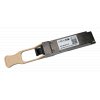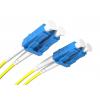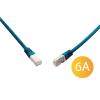-
€
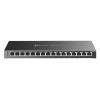
TP-Link SG2016P è uno switch della serie Smart JetStream dotato di 16 porte Gigabit Ethernet (10/100/1000 Mbps). Sulle porte 1-8 è presente un'uscita di alimentazione PoE+ (802.3 af/at); la potenza massima in uscita per porta è di 15,4 W con 802.3 af o 30 W con 802.3 at. Il budget di potenza totale per l'intero dispositivo è di 120 W. Lo switch supporta le funzioni di gestione di livello 2 e le funzioni di base di livello 3. Supporta, tra l'altro, QoS, aggregazione di connessioni, protocolli di spanning tree, multicast (IGMP / MLD Snooping), controllo degli accessi o VLAN. Inoltre, il dispositivo è compatibile con Omada: è possibile gestirlo da una piattaforma centralizzata. Il dispositivo è dotato di raffreddamento passivo e di una custodia metallica di tipo desktop. È possibile posizionare lo switch su una scrivania/scaffale o montarlo a parete; i tasselli devono essere acquistati separatamente.
16 porte Gigabit Ethernet, 8 uscite PoE
Lo switch è dotato di 16 porte Gigabit Ethernet (10/100/1000 Mbps), con uscita di alimentazione PoE+ sulle prime 8. L'SG2016P supporta i protocolli IEEE 802.3 af/at, ampiamente utilizzati nelle telecomunicazioni. È possibile alimentare telecamere IP, telefoni VoIP o punti di accesso, tra gli altri. Grazie alla compatibilità con il sistema Omada, l'SG2016P sarà molto adatto alle aziende che utilizzano la serie EAP. Allo stesso tempo, alimenterà gli access point e consentirà di collegare altri dispositivi alle porte senza supporto PoE.

Alimentazione PoE+ (802.3 af/at)
Il prodotto offerto dispone di 8 porte con uscita di alimentazione PoE+ e supporta i protocolli IEEE 802.3 af/at. La potenza di uscita per porta è di 15,4 W con 802.3 af o 30 W con 802.3 at. Il budget di potenza totale per l'intero dispositivo è di 120 W. Con PoE, è possibile far passare un solo cavo verso il dispositivo di destinazione, che invia contemporaneamente dati e alimentazione.

Controllo degli accessi
È possibile utilizzare liste di controllo degli accessi (ACL), il cui numero massimo di voci è 230.


Funzione QoS
Consente il controllo della larghezza di banda e permette di creare fino a 8 code di priorità. Dà priorità alle azioni più importanti degli utenti, aumentando così la qualità complessiva della trasmissione.
Supporto VLAN
Lo switch consente la separazione delle VLAN per semplificare la gestione di gruppi di dispositivi e aumentare la sicurezza della rete.

Omada SDN
La piattaforma SDN viene utilizzata per integrare tutti i dispositivi compatibili e fornire una gestione centralizzata dal cloud. È possibile creare una rete molto grande che viene gestita da un unico livello. Il vantaggio più importante di Omada SDN è la sua elevata scalabilità. L'espansione della rete con segmenti o interfacce aggiuntive non è molto problematica e non comporta tempi di inattività.
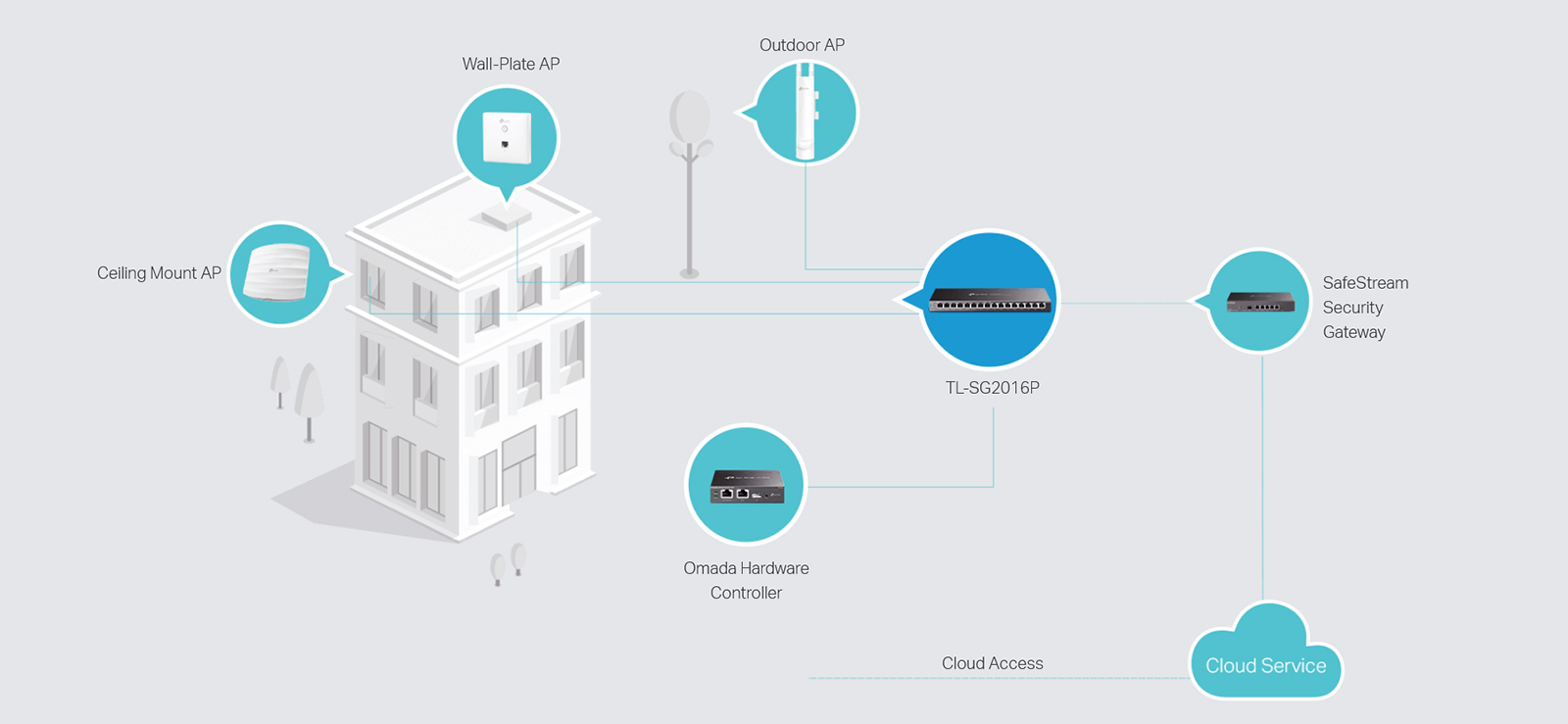
App Omada
Per la gestione e la configurazione è possibile utilizzare l'applicazione Omada disponibile per dispositivi mobili Android e iOS. La configurazione iniziale consiste in alcuni semplici passaggi che l'app vi guiderà rapidamente. È possibile gestire l'SG2016P sia in modalità stand-alone che in modalità controller.
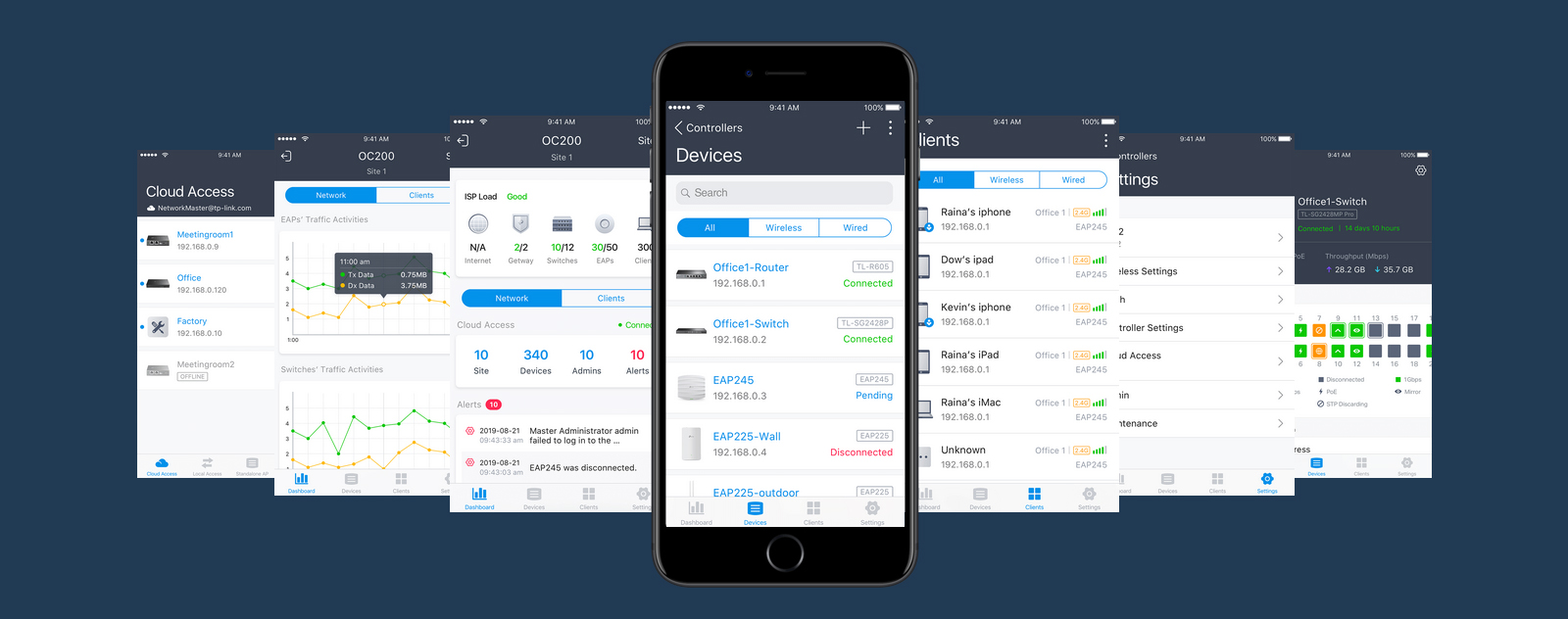
Caratteristiche
| TP-Link SG2016P | |
| Caratteristiche hardware | |
|---|---|
| Standard e protocolli | IEEE 802.3i, IEEE 802.3ab, IEEE 802.3ad, IEEE 802.3af, IEEE 802.3at, IEEE 802.3x, IEEE 802.1d, IEEE 802.1s, IEEE 802.1w, IEEE 802.1q, IEEE 802.1p, IEEE 802.1x |
| Porte |
16 porte Gigabit Ethernet 10/100/1000 Mbps RJ45 (uscita PoE+ sulle porte 1 - 8) Negoziazione automatica della velocità Incrocio automatico MDI/MDIX |
| Cablaggio di rete | 10BASE-T: Cavo UTP cat. 3, 4 lub 5 (fino a 100m) 100BASE-TX/1000Base-T: Cavo UTP cat. 5, 5e, s superiore (fino a 100m) |
| Raffreddamento | Passivo |
| Alimentazione | Alimentazione esterna (tensione di uscita: 53,5 V CC / 2,43 A) |
| Porte PoE (RJ45) | Standard: 802.3af/at Porte PoE: 8 portów Alimentazione: 120 W |
| Dimensioni (S x G x W) |
286 x 111.7 x 25.4 mm (11.3 x 4.4 x 1.0 pollici) |
| Montaggio | Desktop / a parete |
| Consumo massimo di energia | 146.5 W (110 V/60 Hz) (con dispositivi alimentati collegati 120 W) |
| Calore generato | 499.98 BTU/hr (110 V/60 Hz) (con dispositivi alimentati collegati 120 W) |
| Prestazioni | |
| Velocità di trasmissione | 16 Gb/s |
| Tabella indirizzi MAC | 8k |
| Buffer di pacchetti | 4,1 Mb |
| Jumbo frame | 9 KB |
| Caratteristiche del software | |
| Funzione Quality of Service | Supporto per la prioritizzazione 802.1p CoS/DSCP 8 code di prioritizzazione Modalità di pianificazione delle priorità: SP (Strict Priority) WRR (Weighted Round Robin) Configurazione della ponderazione delle code Controllo del throughput Limitazione della velocità di trasferimento in base alla porta/flusso di dati Funzionamento più fluido Storm Control
|
| Funzioni L2 e L2+ | DHCP Relay
Aggregazione di link Aggregazione statica dei collegamenti Fino a 8 gruppi di aggregazione e fino a 8 porte per gruppo
LLDP/ LLDP-MED 802.1ab |
| L2 Multicast | 511 Gruppi multicast IPv4 e IPv6 condivisi IGMP Snooping
Filtraggio dei pacchetti Multicast MLD Snooping
|
| Funzioni avanzate | Rilevamento automatico del dispositivo Batch Configuration Batch Firmware Upgrading Monitoraggio intelligente della rete Avvisi su eventi insoliti Configurazione unificata Pianificazione del riavvio |
| Supporto IPv6 | IPv6 Dual IPv4/IPv6 Multicast Listener Discovery (MLD) Snooping Funzione neighbor discovery (ND) utilizzata dai nodi IPv6 Path maximum transmission unit (MTU) discovery ICMP v6 TCPv6/UDPv6 Applicazioni del protocollo IPv6:
|
| Reti VLAN | Gruppi VLAN
Indirizzo MAC VLAN Protocollo VLAN GVRP VLAN voce |
| Elenchi di controllo degli accessi | Supporto per un massimo di 230 voci Intervalli di tempo Quantum di tempo Intervallo di tempo per settimana Intervallo di tempo universale Periodo di vacanza Elenco di controllo degli accessi (ACL) basato sul tempo Indirizzo MAC ACL
Indirizzo IP di origine Indirizzo IP di destinazione Protocollo IP Flag TCP
Legame delle porte Binding VLAN Azioni per i flussi Mirror (verso l'interfaccia supportata) Redirect (a un'interfaccia supportata) Limite di velocità
|
| Sicurezza della trasmissione |
AAA Address binding IP/IPv6 e MAC
Gestione sicura basata sul Web tramite HTTPS con crittografia SSLv3/TLS1.2 Gestione sicura della CLI con crittografia SSHv1/SSHv2 Controllo dell'accesso basato su IP/Porta/MAC |
| MIB | Data base MIB II (RFC1213) Bridge MIB (RFC1493) P/Q-Bridge MIB (RFC2674) Radius Accounting Client MIB (RFC2620) Radius Accounting Client MIB (RFC2618) Pakiety Ping e Traceroute su interfaccia remota MIB (RFC2925) Supporto del database MIB privato di TP-Link RMON MIB (RFC1757, RMON 1,2,3,9) |
| Gestione | |
| App Omada | Sì (tramite OC300, OC200, controller basato su cloud Omada o controller software Omada) |
| Gestione centrale | Controller Omada basato su cloud Controller hardware Omada (OC300) Controller hardware Omada (OC200) Controller software Omada |
| Accesso al cloud | Sì (tramite OC300, OC200, controller basato su cloud Omada o controller software Omada) |
| Configurazione ZTP senza manutenzione | Sì. Richiede l'uso del controller Omada basato su cloud. |
| Funzioni del pannello di gestione | Interfaccia grafica GUI Interfaccia a riga di comando CLI SNMP v1/v2c/v3 SNMP Trap/Inform RMON (grupy 1, 2, 3, 9) Modello SDM Client DHCP/BOOTP Dual Image, Dual Configuration Monitoraggio dell'utilizzo della CPU Diagnostica dei cavi EEE SNTP Log di sistema |
| Altre caratteristiche | |
| Configurazione | TL-SG2016P Alimentazione Manuale di installazione Piedini in gomma |
| Requisiti del sistema | Microsoft® Windows® 98SE, NT, 2000, XP, Vista™ lub Windows 7/8/10/11, MAC® OS, NetWare®, UNIX® lub Linux. |
| Temperatura di funzionamento consentita | Da 0 a 40 C |
| Temperatura di stoccaggio consentita | Da -40 a 70 C |
| Umidità dell'aria ammessa | 10%-90% senza condensa |
| Umidità dell'aria ammessa durante lo stoccaggio | 5%-90% senza condensa |






 Polski
Polski English
English Italiano
Italiano Español
Español Čeština
Čeština Српски
Српски Deutsch
Deutsch Ελληνικά
Ελληνικά Slovenský
Slovenský

